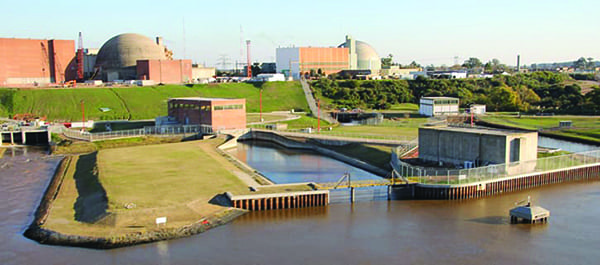China, Russia Looking to Build Nuclear Plants in Argentina
Argentina, the first Latin American country to adopt nuclear power when the Atucha I plant began operation in 1974, has plans to expand its nuclear generation, with Russia and China vying to implement their technology.
Argentina and Russia set up a working group to site and build a nuclear plant, government officials said on May 28. That was just weeks after the administration of Argentine President Mauricio Macri and China's National Energy Administration agreed on financing for the Atucha III nuclear plant near Buenos Aires, which is expected to come online in 2021. The financing deal, which includes a $10 billion loan from the Industrial and Commercial Bank of China (ICBC), covers an estimated 85% of the plant's expected construction cost. The Atucha III project is part of an agreement signed in 2015 by former president Cristina Fernindez de Kirchner, a deal that supported using Canadian technology in Argentina's existing nuclear plants, along with backing at least three new plants using Chinese technology. China has pushed for using its Hualong One technology at Atucha III. The Hualong One is a pressurized water reactor currently being tested at the Fuqing nuclear power plant in China's Fujian province.
 |
1. The Atucha I and Atucha II nuclear plants are located near Buenos Aires. The new Atucha III reactor would be sited at the same complex. Courtesy: Nucleoeli(C)ctrica Argentina |
Argentina has three operating nuclear reactors: Atucha I, with a 340-MW pressurized heavy water reactor (PHWR); Atucha II, which came online in 2014 with a 692-MW PHWR and is located in the same Buenos Aires province complex as Atucha I (Figure 1); and the 635-MW Embalse plant, also with a PHWR, in Cordoba province, which has operated since 1983. Atucha II was named a POWER Top Plant in 2015.
Sergey Dankvert, chairman of the Russian-Argentine intergovernmental commission, speaking after the commission's meeting in Buenos Aires on May 28, told media, "The working group is tasked with specifying all matters pertaining to this project," including selecting a location, about which he said, "We think that we may [soon] see a very serious breakthrough in this sphere." Dankvert, who also leads the Russian agricultural group Rosselkhoznadzor, said Russia and Argentina are discussing cooperation in several areas after agreeing "to focus efforts on searching for and implementing joint projects in the spheres of energy, industry, and transport, peaceful atom and space exploration, agriculture, and other spheres of mutual interest." Added Dankvert: "Argentina has many deposits which need to be developed. We can totally do this, considering the experience, including in the sphere of hydraulic fracturing. We have discussed all of this."
The nuclear deal with China is part of what officials have called "an integral strategic alliance," something China has said it has with few countries. China and Argentina signed more than 20 treaties for bilateral cooperation during Kirchner's time in office. Macri and Chinese President Xi Jinping at last year's G20 Summit in Buenos Aires signed a joint five-year action plan (2019-2023), though negotiations on nuclear technology had stalled until Macri's office announced financing for Atucha III in April.
Macri, who succeeded Kirchner in 2015, had questioned that year's nuclear deal with China shortly after taking office, saying he had doubts about how to pay for nuclear projects in light of the country's economic problems. Those doubts apparently were assuaged with ICBC agreeing to finance most of Atucha III's construction, although Macri has postponed action on two additional reactors included in the original China deal with Kirchner. Diego Guelar, Argentina's ambassador to China, recently said, "The [new] agreement shows the level of maturity of our strategic relationship." China's state-owned China National Nuclear Corp. is expected to build Atucha III along with Argentina's state-owned Nucleoelectrica.
Thermal generation, more than half of it from natural gas, accounts for about 85% of Argentina's power generation, with nuclear power providing about 5%, according to government data. The country has about 10 GW of installed hydropower capacity, according to the World Energy Council, and also has small amounts of geothermal, wind, and solar generation. Solar and wind energy are growing, with the government recently accepting tenders for 147 projects totaling 4,466 MW. The plan to add more nuclear generation has been criticized by some former Argentine officials; a group of former energy secretaries in November 2018 issued a press release, saying the country would be better served by developing more wind and solar projects.
"Any future energy projects have to be part of a national and long-term energy plan, which now doesn't exist," said Jorge Lapena, a former energy secretary. "All new projects should be economically competitive and should be in line with the country's mitigation commitments." Andri(C)s Nipoli, head of Fundacion Ambiente y Recursos Naturales (FARN), or Environment and Natural Resources Foundation, said, "We don't consider nuclear as renewable energy, it has many risks regarding the functioning of the reactors and waste. It's not suitable for Argentina."
-Darrell Proctoris a POWER associate editor.
The post China, Russia Looking to Build Nuclear Plants in Argentina appeared first on POWER Magazine.